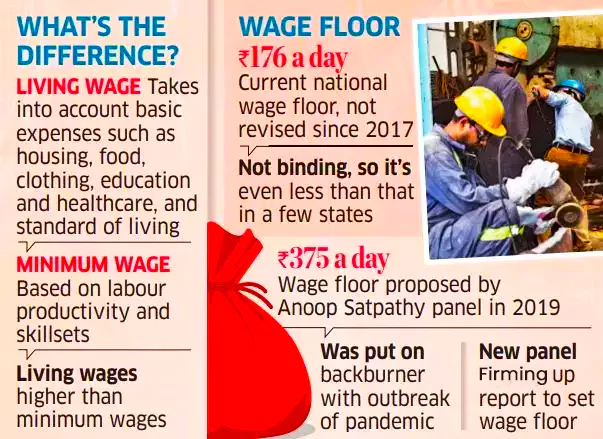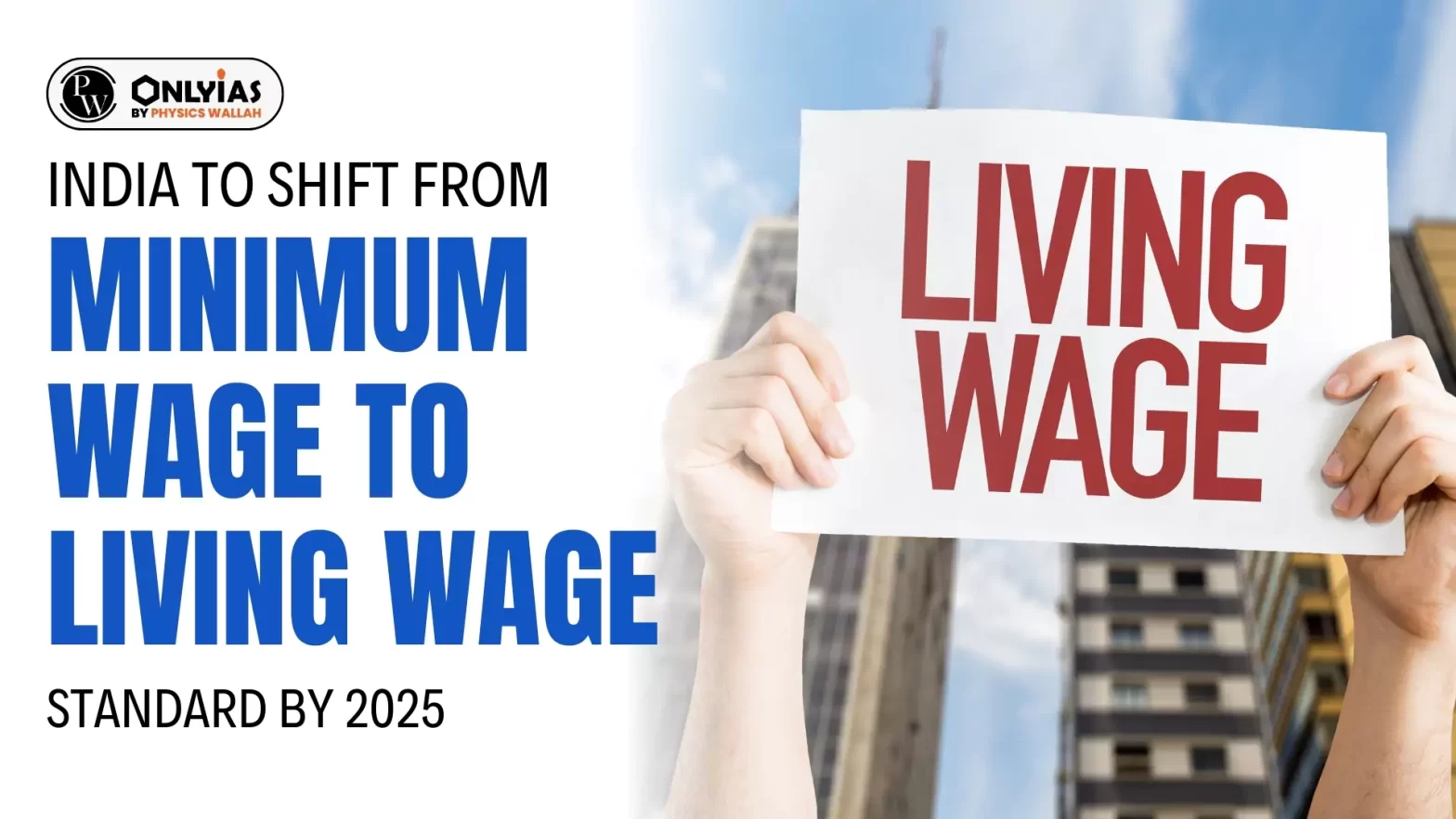Context
India is set to replace its minimum wage system with a living wage system by 2025.
India Wants to Establish a Living Wage Standard by 2025
- Assistance from ILO: The government is seeking technical assistance from the International Labour Organisation (ILO) to develop a framework for estimating and implementing the living wage.
- Endorsement by ILO: The move follows the ILO’s recent endorsement of the concept of a living wage.
- The endorsement came after an agreement was reached during a Meeting of Experts on wage policies which was subsequently endorsed by the ILO’s governing body.
International Labour Organization (ILO)
- About: International Labour Organisation (ILO) was established in 1919 as part of the Treaty of Versailles that concluded World War I, to reflect the notion that universal and enduring peace can only be achieved through social justice.
- Goal: To promote social justice and internationally recognised human and labor rights, based on its basic goal that labor peace is critical to prosperity.
- Headquarters: Geneva, Switzerland.
- Member States: The ILO has 187 state members.
- Status of India in ILO: India was a founding member of the ILO and has served as a permanent member of its Governing Body since 1922.
- Flagship reports:
-
- Global Wage Report
- World of Work Report
|
Current Wage System in India
- National Floor Level Minimum Wage (NFLMW): Under the new Code on Wages 2019, the NFLMW is set by the government which mandates the establishments to set the minimum wage not less than the NFW.
- Flexibility of Minimum Wage Standards: As per Section 5 of the Code on Wages 2019, no employer can fix the minimum wage below it.
- However, it’s not a mandatory provision, the minimum wage rates can be revised accordingly by the State.
- Currently, the National Floor Wage is Rs 178 per day.

What is Living Wage?
- According to the ILO, the living wage is defined as the level of remuneration “necessary to afford a decent standard of living for workers and their families, taking into account the country’s circumstances and calculated for the work performed during the normal hours of work”.
- This decent standard of living includes being able to afford food, water, housing, education, healthcare, transportation, clothing and other basic needs including a provision for contingencies.
About Minimum Wage
- Definition: Minimum wage is the lowest amount of remuneration required by law to be paid by employers to employees for work performed during a given period.
- Difference with Living Wage: While the minimum wage aims to protect workers from low pay, the living wage goes further by providing enough income to cover basic needs such as food, clothing, shelter, and more. Despite earning minimum wages, workers often fall below the poverty line.
- Basis for Calculation: In India, the minimum wage is calculated on the basis of the state, worker’s skill level and the nature of their work among other factors.
| Fair Wage: It comes after minimum wage which surpasses the minimum threshold yet falls below what’s required for a living standard.
While the minimum wage sets the baseline, the upper boundary of a fair wage is determined by the industry’s financial capability to compensate. |
Legislations on Minimum Wage
- Minimum Wages Act, 1948: Until 2019, the minimum wages were fixed through the Minimum Wages Act, 1948.
- Under this, the Central government fixed the wages of the workers engaged in scheduled employment such as railways, oilfields, etc while the authority to decide the minimum wage for the rest went to the State government including the private sector.
- The Code of Wages, 2019: It was introduced in an attempt to bring uniformity in the implementation of legal policies governing the payment of wages.
- It states that the minimum wage cannot be fixed below the National Wage Floor (NFW). However, this code, which is binding on all states, is yet to be implemented.
Need for Living Wage Standard and Its Significance
- Insufficiency to Meet Basic needs: Addressing worker concerns about the current minimum wage, which is seen as insufficient to meet basic needs, especially with inflation.
- According to the data, 45% of salaried workers earn less than Rs 9750 on monthly basis which is not appropriate for a worker to support himself and his family.
- They often fall below the poverty line after getting minimum wages.
- Alleviating Poverty: The shift from minimum wages to living wages is aimed at accelerating efforts to lift millions out of poverty and ensure their well-being.
- Wage Discrepancies: There are over 500 million workers in India and 90% of them are in the unorganised sector where many draw a daily minimum wage of `176 or more, depending on the state where they work.
- However, this national wage floor — not revised since 2017 — is not binding on states and hence a few states pay even less than that.
- Surveys have shown that almost 80 per cent of the workers in the unorganized sector earn less than 208 rupees a day, or less than half the government-stipulated rural minimum wage of 49 rupees a day and urban wage of 67 rupees.
- Achieving SDGs: India is committed to achieving the Sustainable Development Goals (SDGs) by 2030, including the goal of promoting decent work and economic growth.
- It is believed that replacing minimum wages with living wages could fast-track India’s efforts to pull millions of its people out of poverty while ensuring their wellbeing.
- Reducing Inequalities: Since the early 2000s, India’s inequality has increased significantly, with the top 1% owning 22.6% of the country’s income.
- Therefore, in order to address this inequality, India needs to redesign its wage structure.
- India’s strong economic growth, with a rate of 8.4 per cent, indicates the country’s capacity to support higher wages.
- Positive Work Culture: Higher wages can boost employee morale, leading to increased productivity, reduced turnover rates, and improved customer satisfaction.
- By investing in the well-being of their employees, businesses can create a positive work environment that fosters loyalty and a strong work ethic.
Challenges in Implementation of Living Wage Standard
- Diversity in Living Costs: The cost of living varies significantly between cities, states, and even districts, making it challenging to establish a uniform living wage rate.
- According to a Cost of Living City ranking of 2022, Mumbai emerged as the most expensive Indian city with a rank of 127 followed by New Delhi (155).
Provision for Living Wage under the Indian Constitution:
- According to Article 43, the State shall endeavour to secure, by suitable legislation or economic organisation to all workers, agricultural, industrial or otherwise, work, a living wage.
|
- Unorganised Sector: Of the nearly 500 million strong workforce, most of them are employed with the unorganised sector which falls outside the purview of scrutiny.
- Fiscal Implications: For the government, the fiscal implications could weigh heavily on the size of public debt.
- Private-sector employers, on the other hand, would be reluctant to pay higher than necessary wages in fear of lower profits.
- Imposing a living wage means creating a wage floor, which would hurt the economy by impacting businesses, especially those that cannot pay hiked salaries.
- Lack of Awareness: There is a lack of awareness amongst the workers about minimum wage provisions and their entitlement under the labour laws.
- This is particularly true in remote areas and in areas where workers are not unionized or organized. As a result, their wages have failed to keep pace with rising costs and continue to diminish in real value over time.
- Potential Impact of Automation and the Gig Economy on Wages: The rise of automation and the gig economy presents unique challenges for maintaining fair compensation for workers.
- As technology advances, certain jobs may become obsolete or undergo significant transformations.
Way Forward
-
Government Legislation and Policies for Living Wage:
-
- By enacting laws that establish minimum wage standards, governments can set a baseline for fair pay.
- However, to truly address the issue of living wages, governments must push beyond minimum wage laws and consider comprehensive policies that take into account the cost of living.
National Multidimensional Poverty Index in India:
- It measures simultaneous deprivations across the three equally weighted dimensions of health, education and standard of living that are represented by 12 sustainable development goals-aligned indicators.
|
-
Incorporating Multidimensional Indicators in Calculating Poverty:
- ILO must take into account health, education and standard of living as key indicators to arrive at a definition of living wages as these measures are used to assess the national multidimensional poverty in India.
- The standard of living component must include the components of economic, social and demographic factors.
-
Inflation Adjusted Wage:
-
- The minimum salary needs to be adjusted regularly to keep pace with the inflation.
-
Overcoming Challenges in Living Wage Implementation:
- Support to small businesses and industries that may struggle with increased labor costs.
- Governments can incentivize businesses to pay living wages through tax credits, grants, or procurement policies.
Case Studies:
- United Kingdom: Many organizations that have adopted the living wage standard have reported increased employee satisfaction, reduced turnover rates, and improved productivity.
- United States: The city of Seattle raised its minimum wage to $15 per hour, which is considered a living wage in the area. The move has led to improved working conditions for low-wage workers and has been heralded as a step towards a more equitable society.
|
-
-
- Additionally, organizations can collaborate with employers to develop innovative approaches, such as shared responsibility models, that distribute the costs of living wages more equitably.
-
Collective Bargaining in Wage Setting:
- Negotiations and collective bargaining play a vital role in the establishment of fair wages.
- By empowering workers to collectively negotiate their wages and working conditions, unions can ensure that workers’ interests are effectively represented and protected.
-
Adaptation and Innovation:
- Policymakers, businesses, and labor advocates must collaborate to ensure that the transition to automation and the gig economy does not result in a widespread erosion of worker rights and fair compensation.
- By harnessing the power of technology, a future may be created where automation complements human labor and where gig workers receive fair pay and benefits.
-
Integration of Living Wages into Sustainable Development Goals:
-
- By aligning living wages with the broader framework of sustainable development, we can strengthen the global commitment to fair compensation and accelerate progress towards a more just and prosperous future for all.
Conclusion
India’s aim to replace the minimum wage with a living wage by 2025 represents a significant step towards improving the lives of Indian workers. The government’s commitment to developing a well-defined and operational system, with technical assistance from the ILO, is crucial for the successful implementation of this policy. Balancing affordability for businesses with ensuring worker well-being will be key to achieving this goal.
![]() 28 Mar 2024
28 Mar 2024


